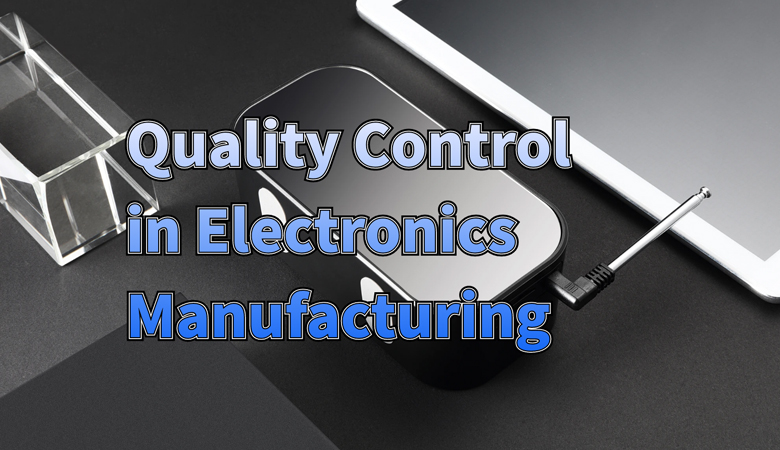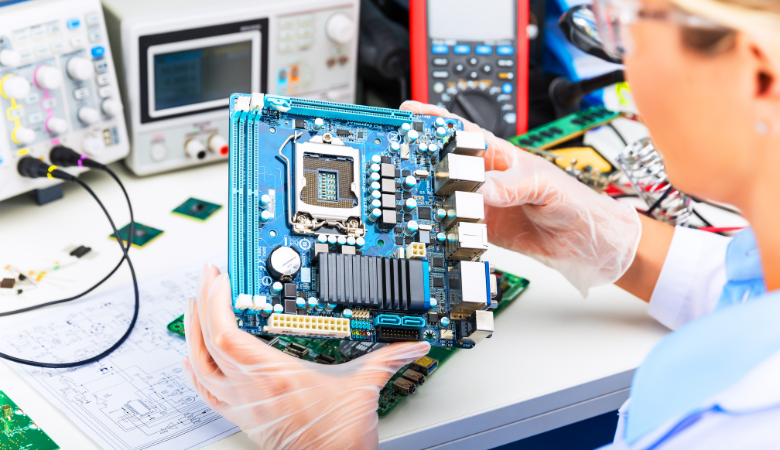
In the fiercely competitive electronics manufacturing industry, maintaining the highest quality standards is crucial for ensuring product reliability, customer satisfaction, and brand reputation. Quality control (QC) plays a pivotal role in preventing defects, ensuring compliance with industry standards, and enhancing overall production efficiency. Implementing an effective quality control system necessitates a structured approach that clearly outlines each step.
This article discusses the key steps for implementing quality control in electronic manufacturing and highlights their importance in the production process.

Establish clear quality control standards
Define quality benchmarks for electronic products
These benchmarks establish acceptable levels for the performance, safety, and durability of electronic products, providing manufacturers with a yardstick for measuring product quality. By setting such standards, manufacturers can maintain product consistency across different production batches, ensuring that each product meets the established quality requirements and meets or even exceeds customer expectations.
The quality control benchmark should encompass multiple key aspects. Electrical safety is an indispensable part, ensuring the safety of users whether the electronic product is used normally or under potential misuse conditions. Product lifespan is a crucial metric for assessing the durability of electronic products, pertaining to the duration of time the product can operate stably and continuously. Functionality is the core of electronic products, requiring the product to operate normally according to design specifications and fulfill all anticipated functions. Furthermore, appearance is also a significant aspect that cannot be overlooked, influencing consumers' first impression of the product. It is imperative to ensure that the product's appearance aligns with design requirements and exhibits no noticeable defects.
Align with international standards (ISO, IEC, etc.)
Aligning the quality control process with international standards is a crucial step in ensuring the reliability and compliance of electronic products.
International standard organizations such as ISO (International Organization for Standardization) and IEC (International Electrotechnical Commission) have established a series of globally recognized frameworks for quality assurance, safety, and environmental impact. These standards provide clear guidance and specifications for the production of electronic products, ensuring that they meet the expectations and legal requirements of the global market.
Aligning with international standards means that manufacturers need to comply with the various requirements and testing methods stipulated in these standards. This not only enhances the quality and reliability of products but also boosts their competitiveness in the international market. Products that meet international standards are more likely to gain the trust and recognition of consumers, who generally prefer products that have undergone international certification and have guaranteed quality.
Develop a comprehensive quality control plan
Establish a structured quality control plan for the entire production cycle
To ensure the quality of electronic products, a comprehensive and structured quality control plan should be formulated. This plan should cover the entire production cycle, extending from the initial product design stage to the final product testing phase, ensuring that every link is subject to strict quality monitoring.
In this comprehensive quality control plan, each production stage will be assigned specific quality control procedures.
Starting from the inspection of raw materials, we ensure that all materials entering the production line meet the established quality standards. The process involves testing the physical and chemical properties of raw materials, which may include reviewing supplier qualifications and conducting regular assessments. Subsequently, during the production process, a series of process checkpoints will be set up to monitor the operational status of the production line and the quality level of products in real-time. These checks may include online monitoring, sampling inspection, and on-site supervision of key processes, aiming to detect any possible deviations or defects as early as possible.
The final product testing is the concluding phase of the quality control plan and a crucial step in ensuring that the product meets design specifications and customer demands. This phase of testing comprehensively evaluates the functionality, performance, safety, and durability of the product, ensuring that each product meets or even exceeds customer expectations.
By organizing the quality control process in such a structured manner, manufacturers can develop a systematic approach to quality management.
Identify the critical control points (CCP) in the manufacturing process
In the manufacturing process, there are certain stages that have a significant impact on the quality of the final product, and these stages are referred to as Critical Control Points (CCPs).
Taking electronic manufacturing as an example, the soldering process is a typical CCP. The quality of soldering directly affects the reliability and service life of electronic products. In this process, strict quality inspection is required, including visual inspection of solder joints, electrical conductivity testing, and evaluation of soldering strength. Component placement is also a key control point. The correct placement and fixation of components are the basis for ensuring the normal function of electronic products. Strict inspection and confirmation of component model, specifications, position, and fixation method are necessary.
In addition, electrical continuity testing is also an indispensable CCP in the electronic manufacturing process. The testing is typically used to verify whether the internal circuit connections of electronic products are correct, ensuring smooth signal transmission and normal function realization. By implementing strict quality inspection at these key control points, manufacturers can significantly reduce product defects and ensure product consistency and reliability.
Inspection during implementation
Conduct regular inspections during the production process
Process inspection is crucial for ensuring that products meet quality standards throughout the entire production process. Regular inspections at different production stages can identify defects early on, minimizing the risk of rework or defects in the final product. Inspection should be conducted at multiple stages, including raw material inspection, assembly process, and final pre-inspection.
Process inspection types (such as visual inspection, functional inspection, and dimensional inspection)
Process inspection is not rigid and unchanging, but rather employs a variety of flexible and diverse methods based on different products and production stages.
Visual inspection is an intuitive and effective method of examination. Inspectors can carefully observe the appearance of the product with the naked eye or with the aid of auxiliary tools, searching for defects such as scratches, cracks, or missing components. Although this method of inspection is simple, it can quickly identify many obvious issues.
Functional inspection is crucial to ensure that the product works as expected. By simulating the actual usage scenarios of the product, inspectors can test whether its various functions are working properly. For example, for electronic products, it is possible to test whether the circuit is unobstructed, whether the buttons are responsive, and whether the display screen displays clearly. This inspection method can directly reflect the performance and quality level of the product.
Dimensional inspection is a crucial step in verifying whether components and assembled parts comply with specified dimensions and tolerances. In electronic products, many components require precise coordination to function properly. Strict inspection of the dimensions of components and assembled parts is key to ensuring the quality of product assembly and stability of performance. Through dimensional inspection, issues such as dimensional discrepancies or tolerance violations can be promptly identified and corrected, ensuring the assembly accuracy and reliability of the product.
Continuous monitoring and feedback
Monitor the quality control process through data collection
In the manufacturing industry, continuously monitoring the quality control process is a crucial aspect to ensure product quality and enhance production efficiency. Through comprehensive and systematic data collection, manufacturers can track the performance of the production line in real time, promptly capture various dynamic changes in the production process, and accurately identify potential trends or problem areas.
In every aspect of inspection, testing, and production, we pay close attention to data collection and organization. These data encompass not only the various performance indicators of the product but also cover various operational parameters and environmental factors during the production process. Through in-depth analysis of these data, manufacturers can obtain valuable first-hand information, providing solid data support for subsequent decision-making.
In this process, tracking key performance indicators (KPIs) is particularly crucial. KPIs such as defect rate, pass rate, and cycle time are core indicators for measuring production quality and controlling efficiency. By monitoring the changes in these indicators in real time, manufacturers can quickly detect abnormal fluctuations in the production process and take timely measures to adjust and optimize it, ensuring the stability and controllability of the production process.
Improve manufacturing practices through feedback loops
Implementing a feedback loop mechanism is a crucial approach for manufacturers to continuously optimize their quality control processes and enhance product quality. By conducting in-depth analysis of data collected from inspections and tests, we can accurately identify areas for improvement in the production process and clarify the direction and objectives for optimization.
This feedback mechanism is not merely a passive coping method, but also an active strategy. It takes into account every detail in the production process and, through continuous trial and error and adjustment, gradually identifies the most suitable production mode and parameter settings.
By incorporating feedback results into the production process, manufacturers can achieve continuous improvement and optimization of the production line. This improvement is not only reflected in the enhancement of product quality, but also includes various aspects such as the improvement of production efficiency, optimization of cost control, and enhancement of customer satisfaction. Ultimately, through continuous efforts and innovation, manufacturers can create higher-quality, more efficient, and competitive products to meet the diverse needs of the market.
Document management and reporting
The role of documents in quality control
Document management provides comprehensive and accurate information support for quality control by meticulously recording every data point during the inspection and testing processes, as well as any deviations from quality standards.
These detailed document records document the quality status of every stage of the product, from the receipt of raw materials to the dispatch of finished products. They ensure transparency in quality management, making every stage traceable and verifiable, providing strong evidence for the company to comply with relevant regulations and standards. When facing quality audits or customer inquiries, these detailed document records serve as the most compelling response.
More importantly, accurate documentation can also provide valuable insights for future quality improvement. Through analyzing historical data, we can identify the root causes of quality issues and pinpoint directions and measures for improvement. A data-based decision-making approach makes quality improvement more targeted and effective.
Generate accurate quality control reports to ensure compliance and facilitate improvement
The quality control report meticulously documents the quality status of the product during the production process, encompassing the inspection results of various quality indicators, compliance status, reasons for non-conformity, and the measures taken. These reports furnish the management with a comprehensive quality perspective, enabling them to gain a clear understanding of the product's quality status, promptly identify issues, and take appropriate measures.
Quality control reports typically highlight areas that require improvement. Through in-depth analysis of the data in the report, we can identify patterns and trends of quality issues, providing strong data support for future quality improvement. Based on the continuous improvement approach outlined in the report, it helps to continuously enhance the quality level of products and meet customer expectations and demands.
END
Implementing effective electronic manufacturing quality control requires a systematic approach, encompassing everything from establishing clear quality standards to conducting thorough testing and ongoing monitoring. Each step plays a crucial role in ensuring the production of reliable, high-quality electronic products.
By implementing these key quality control steps, manufacturers can enhance the quality and consistency of their products, which helps meet customer expectations and reduces the risk of defects and recalls.
Ultimately, robust quality control practices contribute to enhancing customer satisfaction, bolstering brand reputation, and boosting market competitiveness.

Smart Sourcing & Quality Assurance Content Team
Article by Smart Sourcing & Quality Assurance Content Team
The Smart Sourcing & Quality Assurance Content Team is dedicated to delivering high-quality, easy-to-understand information that empowers our audience to navigate the complexities of global sourcing and quality assurance. Our team of writers has extensive experience in creating content across various fields, including procurement, supply chain management, quality assurance, market trends, and industry best practices. We specialize in sectors such as apparel, textiles, and consumer goods, providing targeted insights to help businesses in these industries optimize their sourcing strategies, ensure product quality, and maintain a competitive edge in the market.



